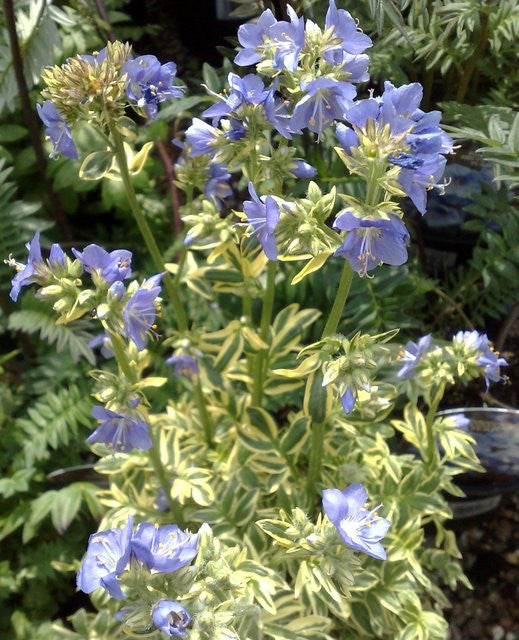Polemonium caeruleum BRISE D’ANJOU 'Blanjou' (v)
Approx. 0.5 litre pot
About this cultivar:
Polemonium caeruleum BRISE D’ANJOU 'Blanjou' is a Jacob’s ladder cultivar that features variegated foliage. It is a naturally occurring mutation that was discovered growing at a nursery in Brissac-Quince, France. The leaves of this cultivar are bright green variegated with creamy yellowish-white edges. Cup-shaped, violet-blue flowers appear in loose, drooping, terminal clusters in spring. The specific epithet caeruleum means sky blue in reference to the flower colour, and Brise D'Anjou means Breeze of Anjou! (Anjou is former French county and type of wine....)
- Position: Full sun, Partial shade
- Soil: Almost any soil, grows well in Ballyrobert
- Flowers: May, June, July
- Other features: Scented, Bees and Butterflies
- Hardiness: Fully hardy, grows well in Ballyrobert
- Habit: Clump forming, bushy
- Foliage: Deciduous
- Height: 30 - 60 cm (1 - 2 ft)
- Spread: 30 - 45 cm (1 - 1.5 ft)
- Time to full growth: 2 to 5 years
- Plant type: Herbaceous Perennial
- Colour: Green, purple, blue
- Goes well with: --
About this genus:
Polemonium (pol-e-mo-ne-um), commonly called Jacob's ladder, is a genus of between 25 and 40 species of flowering plants in the family of it's own name (Polemoniaceae), most of which are native to cool temperate to arctic regions of the Northern Hemisphere.
They are perennial plants (rarely annual plants) growing 10–120 cm tall with bright green leaves divided into lance-shaped leaflets, and produce blue (sometimes white or pink) flowers in the spring and summer. A few of them have a pleasant smell!
The name Polemonium comes to us from the Greek polemos or war'. As one story goes, two princes both claimed to have discovered the plant and from that dispute, the genus name Polemonium was derived. Or it could be from the lance shaped leaves... or it could be that Dioscorides named it after King Polemon of Pontus. Take your pick.
Polemonium plants prefer partial shade and wet-but-not-waterlogged conditions. We've found full sun to be fine (on these islands). If you cut back Polemonium plants in late spring, you may also get a second flush of flowers. Try pairing Polemonium with Astilbe, Heuchera, Carex, or other small spring bloomers.






